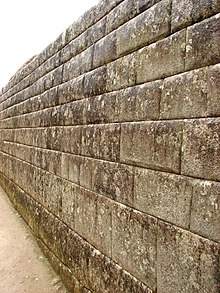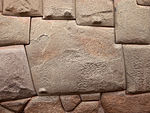| This article may be confusing or unclear to readers. Please help clarify the article. There might be a discussion about this on the talk page. (February 2021) (Learn how and when to remove this message) |




Ashlar (/ˈæʃlər/) is a cut and dressed stone, worked using a chisel to achieve a specific form, typically rectangular in shape. The term can also refer to a structure built from such stones.
Ashlar is the finest stone masonry unit, and is generally rectangular (cuboid). It was described by Vitruvius as opus isodomum or trapezoidal. Precisely cut "on all faces adjacent to those of other stones", ashlar is capable of requiring only very thin joints between blocks, and the visible face of the stone may be quarry-faced or feature a variety of treatments: tooled, smoothly polished or rendered with another material for decorative effect. One such decorative treatment consists of small grooves achieved by the application of a metal comb. Generally used only on softer stone ashlar, this decoration is known as "mason's drag".
Ashlar is in contrast to rubble masonry, which employs irregularly shaped stones, sometimes minimally worked or selected for similar size, or both. Ashlar is related but distinct from other stone masonry that is finely dressed but not quadrilateral, such as curvilinear and polygonal masonry.
Ashlar may be coursed, which involves lengthy horizontal layers of stone blocks laid in parallel, and therefore with continuous horizontal joints. Ashlar may also be random, which involves stone blocks laid with deliberately discontinuous courses and therefore discontinuous joints both vertically and horizontally. In either case, it generally uses a joining material such as mortar to bind the blocks together, although dry ashlar construction, metal ties, and other methods of assembly have been used. The dry ashlar of Inca architecture in Cusco and Machu Picchu is particularly fine and famous.
Etymology
The word is attested in Middle English and derives from the Old French aisselier, from the Latin axilla, a diminutive of axis, meaning "plank". "Clene hewen ashler" often occurs in medieval documents; this means tooled or finely worked, in contradistinction to rough-axed faces.
In tile carpet installation "ashlar" refers to a vertical 1/2 offset pattern.
Use
Ashlar blocks have been used in the construction of many buildings as an alternative to brick or other materials.
In classical architecture, ashlar wall surfaces were often contrasted with rustication.
The term is frequently used to describe the dressed stone work of prehistoric Greece and Crete, although the dressed blocks are usually much larger than modern ashlar. For example, the tholos tombs of Bronze Age Mycenae use ashlar masonry in the construction of the so-called "beehive" dome. This dome consists of finely cut ashlar blocks that decrease in size and terminate in a central capstone. These domes are not true domes, but are constructed using the corbel arch.
Ashlar masonry was also heavily used in the construction of palace facades on Crete, including Knossos and Phaistos. These constructions date to the MM III-LM Ib period, c. 1700–1450 BC.
In modern European masonry the blocks are generally about 35 centimetres (14 in) in height. When shorter than 30 centimetres (12 in), they are usually called small ashlar.
As metaphor
In some Masonic groupings, which such societies term jurisdictions, ashlars are used as a symbolic metaphor for how one's personal development relates to the tenets of their lodge. As described in the explanation of the First Degree Tracing Board, in Emulation and other Masonic rituals the rough ashlar is a stone as taken directly from the quarry, and allegorically represents the Freemason prior to his initiation; a smooth ashlar (or "perfect ashlar") is a stone that has been smoothed and dressed by the experienced stonemason, and allegorically represents the Freemason who, through education and diligence, has learned the lessons of Freemasonry and who lives an upstanding life.
See also
References
- Reich, Ronny; Katzenstein, Hannah (1992). "Glossary of Archaeological Terms". In Kempinski, Aharon; Reich, Ronny (eds.). The Architecture of Ancient Israel. Jerusalem: Israel Exploration Society. p. 312. ISBN 978-965-221-013-5.
- Ching, Francis D. K.; Jarzombek, Mark M.; Prakash, Vikramaditya (2007). A Global History of Architecture. Hoboken, New Jersey: John Wiley & Sons. p. 759. ISBN 978-0-471-26892-5.
- ^ Sharon, Ilan (August 1987). "Phoenician and Greek Ashlar Construction Techniques at Tel Dor, Israel". Bulletin of the American Schools of Oriental Research (267). Boston: The American Schools of Oriental Research: 32–33.
- "The Conservation Glossary". University of Dundee. Archived from the original on 2010-05-19. Retrieved 2009-05-04.
- Wright, George R. H. (2000). Ancient Building Technology, Vol 1: Historical Background. Technology and Change in History. Leiden, The Netherlands: E. J. Brill. p. 100. ISBN 978-90-04-09969-2. OCLC 490715142.
- "Definition of ashlar". Oxford Dictionaries. Archived from the original on August 20, 2017.
-
 One or more of the preceding sentences incorporates text from a publication now in the public domain: Chisholm, Hugh, ed. (1911). "Ashlar". Encyclopædia Britannica. Vol. 2 (11th ed.). Cambridge University Press. p. 733. This also attests the alternative spellings ashler and ashelere.
One or more of the preceding sentences incorporates text from a publication now in the public domain: Chisholm, Hugh, ed. (1911). "Ashlar". Encyclopædia Britannica. Vol. 2 (11th ed.). Cambridge University Press. p. 733. This also attests the alternative spellings ashler and ashelere.
- "Carpet Tile Installation Method". warehousecarpets.net. 3 April 2018. Retrieved 2024-10-22.
- "Ashlar Masonry and its Types". The Constructor. 2018-12-17. Retrieved 2023-05-25.
- Preziosi, D.; Hitchcock, L. A. (1999). Aegean Art and Architecture. Oxford History of Art. pp. 175–6. ISBN 0-19-284208-0.
- "Rough and Perfect Ashlar". Masonic Lodge of Education. Retrieved 15 March 2015.
External links
| Stonemasonry | |
|---|---|
| Types | |
| Materials | |
| Tools | |
| Techniques | |
| Products | |
| Organizations | |
| Native American architecture | ||
|---|---|---|
| Styles |  | |
| Building types | ||
| Structures | ||
| Elements | ||